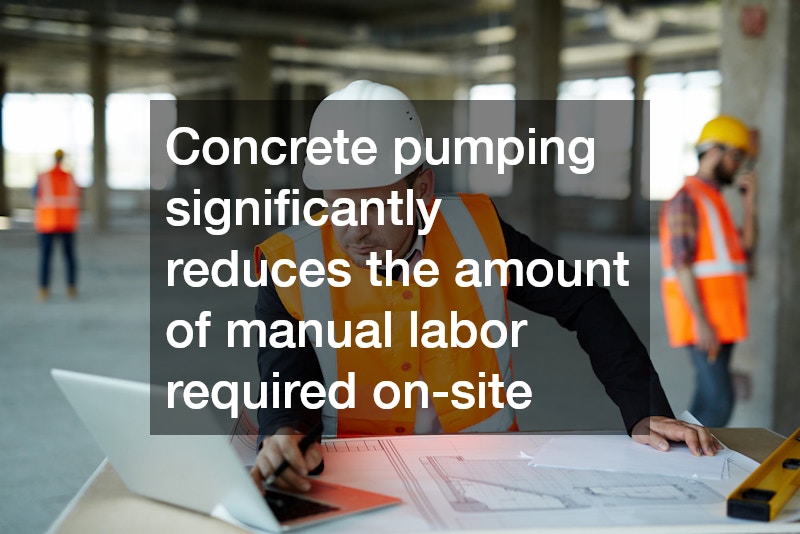A concrete pumping service plays an essential role in enhancing construction site efficiency. By examining common queries about the topic, you can learn how concrete pumping can streamline operations and improve overall productivity on construction sites.
Concrete pumping services have revolutionized the way modern construction projects are completed, offering speed, precision, and efficiency that traditional concrete pouring methods can’t match. By using specialized equipment to transport concrete directly to hard-to-reach areas, contractors can save valuable time, reduce labor costs, and minimize delays caused by manual handling.
This technology ensures a continuous and consistent flow of concrete, leading to stronger, more uniform structures.
Whether for high-rise buildings, residential foundations, or large-scale infrastructure projects, professional concrete pumping services streamline the construction process, improve safety on site, and help projects stay on schedule. Ultimately, this innovative approach enhances overall productivity while maintaining the high quality that today’s demanding construction standards require.
What Is Concrete Pumping and How Does it Work?
Concrete pumping is a method used to transfer liquid concrete through pipes to the desired location on a construction site, ensuring precise placement and minimal labor involvement. Using specialized machinery, concrete pumps can deliver concrete even to hard-to-reach areas, ensuring efficient placement during construction. This technology significantly enhances the speed at which concrete is poured, thereby reducing any delays that can arise during traditional delivery methods.
Concrete pumping operates on a system that utilizes hydraulic mechanisms to push concrete from the mixer to the forming location. This can occur via a boom arm that extends over the site or through flexible hoses, allowing for an unobstructed workflow that keeps the project moving forward.
What Are the Benefits of Using a Concrete Pumping Service?
The benefits of using a concrete pumping service include increased efficiency, faster project completion, reduced labor costs, and improved safety on construction sites. First and foremost, concrete pumping can dramatically speed up the process of pouring concrete due to its ability to cover large distances quickly. This speed translates into shorter project timelines, making it an attractive option for contractors facing tight deadlines.
Additionally, employing a concrete pumping service can lead to cost savings in multiple areas. With the reduction of time spent waiting for concrete to be positioned and less manpower necessary for transportation, construction sites can operate with fewer resources, allowing for budget allocations to be redirected where they are needed most.
How Does Concrete Pumping Reduce Labor Costs?
Concrete pumping significantly reduces the amount of manual labor required on-site, allowing for a more selective use of resources and ultimately leading to reduced overall labor costs. With fewer workers needed to transport and place concrete, contractors can allocate labor more effectively. Instead of a large crew managing wheelbarrows and other manual transport methods, fewer workers can focus on operating pumps and overseeing the pouring, thereby increasing the skill level of the labor employed.
Furthermore, the ease of operation of concrete pumps minimizes the need for specialized labor on the ground, as most laborers can quickly learn to manage such machinery within a short training period. This increased operational efficiency ensures that every member of the workforce is effectively contributing to the task at hand without unnecessary complexity.
What Types of Concrete Pumps Are Available?
There are several types of concrete pumps available, including boom pumps, line pumps, and specialized pumps for different applications, each uniquely suited to specific construction needs. Boom pumps are among the most versatile and can be articulated to place concrete exactly where needed without repositioning the pump itself. Their extended reach allows them to cover significant distances, making them ideal for large projects.
Line pumps, on the other hand, are better for smaller jobs requiring pumping over short distances or in tight spaces. They are typically less expensive to operate, making them a cost-effective option for smaller contractors or residential projects.
How Does Concrete Pumping Improve Job Site Safety?
Concrete pumping enhances job site safety by minimizing the risks associated with manual concrete transportation and placement, creating a safer working environment for all personnel. By reducing the need for workers to manually carry heavy loads of wet concrete, the likelihood of workplace injuries related to lifting and transport is minimized. This leads to a more secure environment, where workers can focus on their responsibilities without the constant danger of strain or injury.
Furthermore, the precision with which concrete can be placed using pumps leads to better-defined working areas, minimizing confusion among laborers and reducing the potential for accidents on busy construction sites. Enhanced oversight and organization help maintain safety protocols that protect all personnel involved.
Utilizing a concrete pumping service can significantly boost efficiency on construction sites. By addressing common concerns and questions about concrete pumping, this article highlights how the technology can streamline processes, reduce costs, and improve safety, making it an essential part of modern construction practices.



